Chevy designers sparked a lot of interest when they unveiled their 1962 Chevrolet C-10 conversion at SEMA this week. In a similar fashion to previous electric "eCrate motor" concepts such as the tire-roasting e-COPO Camaro, capable of sub 10 second 1/4 mile runs, this classic Chevy pickup truck has enthusiasts salivating at the prospect of bringing aging C-10 pickups back to life with a modern electric powertrain.
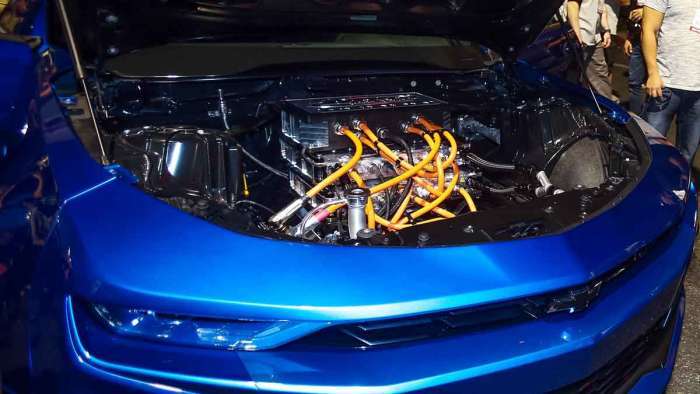
In this story, I’ll go over some of the specs of the “E-10” concept, and I’ll call out and discuss some of the interesting features and potential implications of this platform.
The Chevrolet C-10 Is a Classic
Let’s start with the foundation. These Chevy designers used one of the most iconic pickups in the hotrod and tuning communities: The Chevrolet C-10. As I write this article, I have several friends who are actively wrenching on their own C-10s.
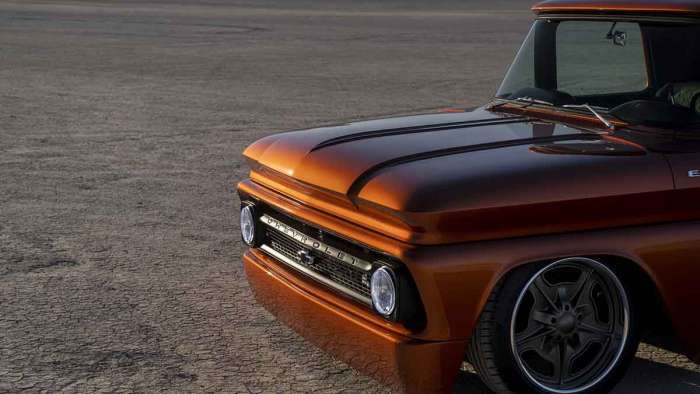
I must admit that I’m a bit biased against the C-10. Back in high school, I used to help a friend keep his C-10 pickup running, and all I remember from that experience was going through a couple quarts of oil a week just to keep its 350 cubic inch V8 engine running. At that point, I told myself that I was done with C-10 pickups.
This E-10 conversion concept might have just made me rethink that position.
The Chevrolet E-10 is Not a “Concept Car”
Before dive into the details, I want to address a point of confusion. This Chevy E-10 concept has spread through the internet and social media like wildfire, and many people were responding to it as though it were a concept vehicle. After all, Bollinger and Rivian have unveiled their upcoming electric trucks, and Tesla will unveil their electric truck later this month. Surely a “truck company” such as GM is showing us the future of their electrified truck platform.
Actually, no. While it’s becoming abundantly clear that GM does have a dedicated electric truck program, that’s not what the E-10 is. Within the classic car and hot rod communities, it is common practice to upgrade vintage cars and trucks with new engines and equipment. This could be done for any number of reasons ranging from just keeping the vehicle running to improving performance.
In the case of the E-10, Chevy’s designers used a “Connect & Cruise” concept crate propulsion system. They are referring to this as an “eCrate” motor, borrowing from hot rod nomenclature. In the past, these “crate” motors were typically larger, more modern internal combustion engines used to replace the aging original engines of classic cars. The newer crate motors were designed to bolt onto the same mounts and use the same transmissions as the original engines.
Like those crate motors, this Connect & Cruise propulsion system is designed to mate to the C-10’s stock SuperMatic™ 4L75-E automatic transmission, which is an important feature for people who are converting these cars themselves in their own garages.
So the concept that Chevrolet was actually showcasing here wasn’t a truck, but rather, a new method for upgrading older, internal combustion trucks.
What the E-10 Has Under the Hood … And Tonneau
The Connect & Cruise powertrain uses components from the Chevrolet Bolt EV powertrain that are retrofitted to work together. I’m really impressed with how the designers installed the dual-motor system, as they were able to orient the two motor controllers to replicate the form and shape of an original V8. My guess is that many a gearhead stood admiring the cool looking valve covers and orange spark plug cables before realizing they weren’t looking at a redesigned internal combustion engine. The value that brings to electric vehicle adoption can’t be overstated.
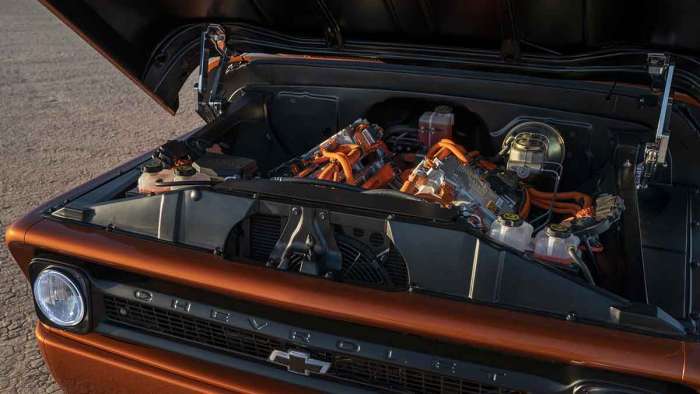
As most EV-heads (hey, we’re almost gearheads, too) will note that an electric vehicle won’t run without batteries. In this case, the Chevy designers mounted two battery packs out of the Bolt EV into the bed of the E-10. These batteries are covered and protected by a hard tonneau cover, which (as is necessary for any good show car) lifts to show the batteries underneath.
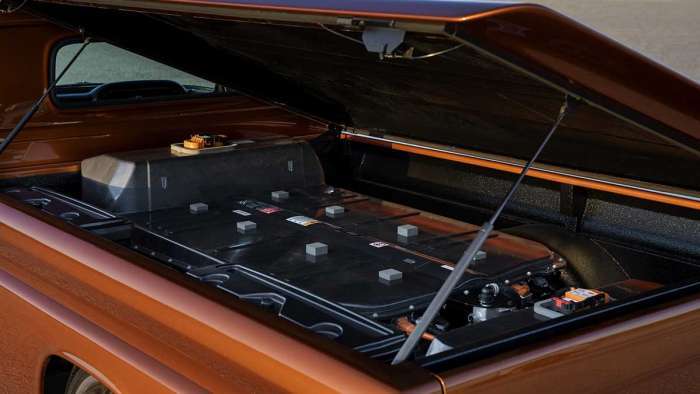
It appears that Chevy was using the previous generation Bolt EV batteries, as each has a capacity of 60 kWh (the 2020 Chevy Bolt EV will come equipped with 66 kWh battery packs that fit the same footprint). This brings the E-10’s total battery capacity up to 120 kWh, which is actually comparable to the battery capacities of the top end Bollinger B1 and entry level Rivian R1T. Not bad for a conversion kit.
Some have criticized the E-10 for no longer being a truck because most of the usable bed space was taken up by the batteries, and that is a fair point. However, I must emphasize my point from earlier. This is not a concept truck, it’s a concept conversion. Also, a classic C-10 is not really considered a work truck. Sure, we still see some old C-10 work trucks on the road, but this conversion kit is really aimed at show trucks. The amount of cargo and hauling capacity is irrelevant. People are going to want to drive these classics around regardless. I’d prefer that they are zero emission rather than running off of 40 year old internal combustion engines.
Chevrolet E-10 Performance
Chevy claims that the E-10 puts down 450 horsepower to the wheels, and it can accelerate from 0 to 60 mph in around 5 seconds, completing the quarter mile in less than 14 seconds. Those are pretty good numbers for a 60 year old truck, and in fact, those numbers are better than what the Chevy Bolt EV itself can achieve.
What I find interesting about this configuration is that the E-10’s power numbers are actually more than double those of the Bolt EV, which means that the motors Chevy is using in the E-10 are actually distinct and different than the Bolt EV’s motors. This could indicate that Bolt EV might see a power upgrade in the future.
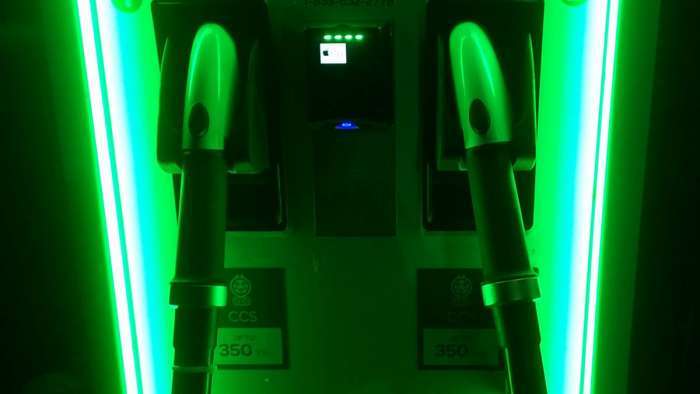
Chevy also noted that the twin battery packs can be charged simultaneously. This means that, at a minimum, the E-10 should be able to charge at 110 kW, putting its charging speed far ahead of many modern electric vehicles. Even when accounting for worse driving efficiency, this E-10 would be likely to have at least 250 miles of range and add over 100 miles of range in 30 minutes on a 150 kW DC fast charger.
Sound Off … Or On?
As much as some EV-heads have scoffed at it, Chevy provided the E-10 with a sound emulator that uses three speakers to simulate induction and V8 sounds. The driver can choose from among five modes, ranging from an LS7 Z28 to silent. These sounds will even adjust and change based on gear changes.
I've already heard from a number of friends who told me how awesome they thought the V8 sound generator was. People who are into classics are also into the sound, and even if it isn't coming from a muffler and exhaust system, they want to hear a rumble. While personally, I prefer silent, I think it was a wise choice by Chevy to offer the option.
In fact, these sound generators can serve a dual purpose. They can not only improve reception for gearheads who love those exhaust notes, the sound generators also can meet regulatory requirements mandating that electric vehicles produce noise to alert pedestrians when driving under 15 mph. Hopefully, these systems will also be adjustable so that the noise levels can be reduced at nighttime.
Final Thoughts
I love the E-10 concept and how quickly the Chevy designers we able to turn this around (less than 18 months); however, I feel that it definitely room for improvement. While some are proponents of preserving the existing transmission systems, I prefer going all-in on electric. That means replacing the bellhousing, transmission, transfer case, driveline, u-joints, and even differentials.
So my preference is to have a single reduction gear mounted to a transaxle. With body-on-frame configuration of many classics, that opens up the possibility of mounting the battery on the undercarriage, between the two main beams of the frame. Additional battery capacity could be housed under the hood and bolted onto the old internal combustion engine mounts. If the engine bay was properly reconfigured, it would still leave enough room for a front motor and transaxle, steering column, charging system, radiators, and possibly some additional storage.
For this to happen, though, Chevy would need to start designing their eCrate motors with a single reduction gear option. Perhaps, by the next time SEMA rolls around, Chevy designers can present two of the same classic Chevys with one converted like the E-10 and one all-in on electric.
Torque News would love to hear what you think about the E-10 concept. Comment below and let us know!
About The Author
Eric Way focuses on reporting expert opinion on GM brand electric vehicles at Torque News. Eric is also an instructional designer and technical writer with more than 15 years of writing experience. He also hosts the News Coulomb video blog, which focuses on electric vehicles, charging infrastructure, and renewable energy. Eric is an active member of the EV Advocates of Ventura County, a volunteer organization focused on increasing the widespread adoption of electric vehicles. You can follow Eric on News Coulomb Youtube, on Facebook at @NewsCoulomb as well as on Twitter at @eway1978.

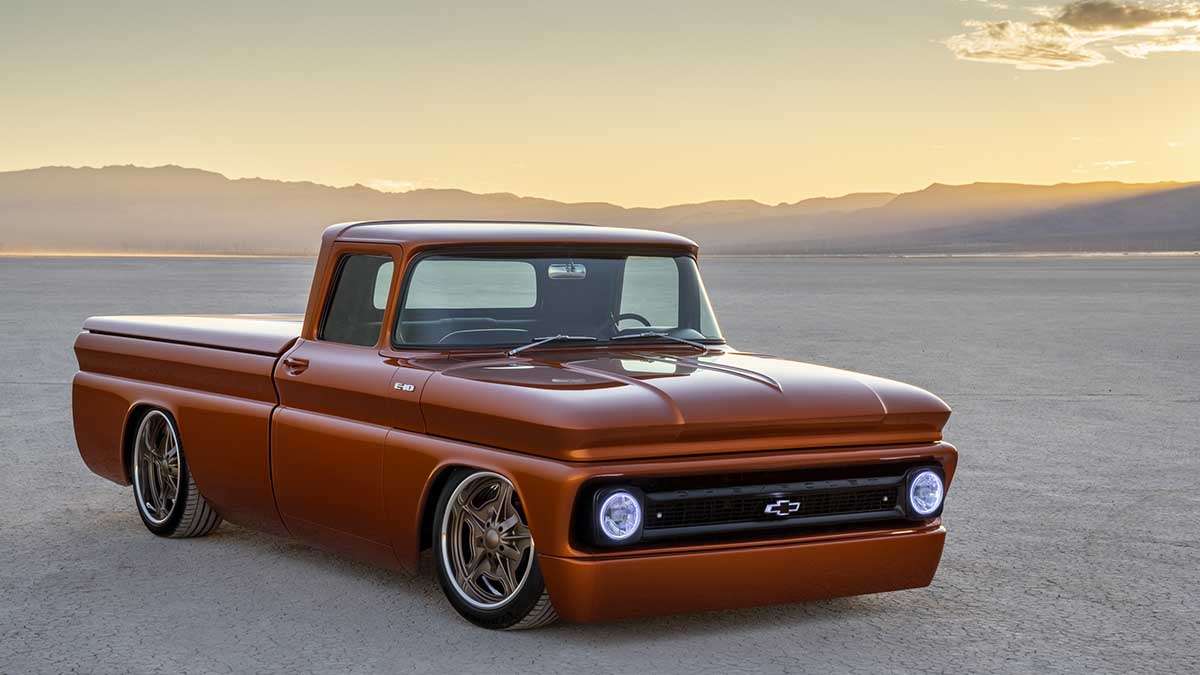




Comments
It is great to see an E-Crate
Permalink
It is great to see an E-Crate, plug and play system come closer to reality so the idea of updating a classic car to become an EV can be done without having to hire a team of EV install experts to design and build up your EV custom car. You have written another thorough and enjoyable article explaining this EV concept and why it exists. However, even though I do understand your idea of having a complete EV drivetrain (without having to adapt to older technology), this is a SEMA introduction, and much of their huge following is racers and hot rodders that are looking to swap in a few parts to easily update their cool ride. Seeing that EV sales still only make up about 3% of new car sales (6% in CA) the whole idea of electric vehicles can be scary, especially to the hot rod community who often prefer earth-shattering engine noises, and smokey burnouts. But over time the idea of EVs have changed from tiny golf-cart eco-boxes, to modern day supercar and musclecar slayers. And building an evolutionary step towards EV conversions that will appeal to traditional car-guys is making an e-crate motor with the prospect of having plug-and-play, drop in motor/battery/electronics that any skilled backyard mechanic can just bolt into their hot rod and drive to a car show or race track and show off. The more custom or complex the installation, the more expensive it will be, and the fewer customers that will take that EV leap. What you have described sounds like a 2.0 version of the e-crate system which an expensive EV tuner or specialty shop would need to install. The hardest parts for EV conversion these days is that even though anyone can buy an electric motor, controller, switches, cabling and gauges for a couple thousand dollars on EBay (for an entry level EV conversion), the main pieces left to overcome are high battery prices, and having a plug-in controller, BMS (battery management system) and related parts, A working solution would be where someone with basic automotive skills can buy the full kit with battery (for around $5,000), do about 40 hours total of install work, and have a running EV with (maybe) 100 miles of range. In contrast these days it is fairly easy to find a low mileage used EV or plug-in hybrid for under $7500 that you can get in and drive today. But that is not the same thing as having your cool classic car with a modern EV drivetrain, which would give you the best of both worlds. But if you are talking about spending $40K+ on a conversion, battery and parts, most EV hunters would just buy one of the great new/stock EVs out there today, and keep their classic car for a once-a-month, weekend drive. me, I'm waiting for the upcoming affordable (and complete) EV conversion kits. The e-crate solutions like GM's Connect & Cruise powertrain sound like a positive step in making that EV dream a reality.